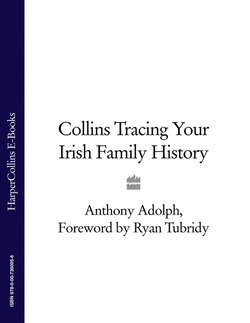Читать книгу Collins Tracing Your Irish Family History - Ryan Tubridy, Anthony Adolph - Страница 29
Pedigree conventions
Оглавление‘=’ indicates a marriage, accompanied by ‘m-’ and the date and place.
solid lines indicate definite connections: dotted lines indicate probable but unproven ones.
wiggly lines are for illegitimacy and ‘x’ for a union out of wedlock – important on old pedigrees but I think it’s time to dispense from this distinction and use straight lines, though ‘x’ instead of ‘=’ seems reasonable enough.
loops are used if two unconnected lines need to cross over, just like electricians’ wiring diagrams.
wives usually go on the right of husbands, though only if that doesn’t interfere with the chart’s overall layout.
Common abbreviations are:
| b. | born |
| bpt or c. | baptised or christened (same thing) |
| bach. | bachelor |
| spin. | spinster |
| unm. | unmarried |
| d. | died |
| bur. | buried |
| d.s.p. or o.s.p. | died without children |
| d.v.p. or o.v.p. | died before father married |
| lic. | marriage licence |
| w.wr./pr. | will written/proved |
| m.i.w. | ‘mentioned in the will of…’ followed by f. for father, gf. for grandfather and so on. |
| inft | infant |
| MI | monumental inscription |
| wid. | widow or widower (as appropriate) |
carried announcements of births, baptisms, marriages, deaths, obituaries and burials. Such announcements can be very terse – ‘to the lady of Michael O’Brien Esq., of Newgrange, Co. Meath, a son’ – but many are far more detailed. They very seldom include the illiterate poor (for obvious reasons), but poor people may be mentioned retrospectively, say, as parents of people who had risen in the world thanks to migration.
You may also encounter advertisements concerning bankruptcy, business partnerships being made and dissolved, and even notices placed by husbands disclaiming financial responsibility for wives who had eloped.
Newspapers are valuable for tracing ancestry and also for adding colour and detail to your ancestors’ stories. Many Irish immigrants and their descendants came from poor backgrounds in Ireland, yet made great successes of themselves in their places of settlement. The rise to prosperity of families of farmers, businessmen and politicians is often well chronicled in newspapers. Especially useful are obituaries of Irish migrants, or their children or grandchildren. American newspapers are very good for this, and may state the Irish place of origin of the parent, grandparent or even earlier ancestor of the deceased. So if you have no American ancestors but know of cousins who settled there, you might discover your Irish roots by seeking their American newspaper obituaries.
